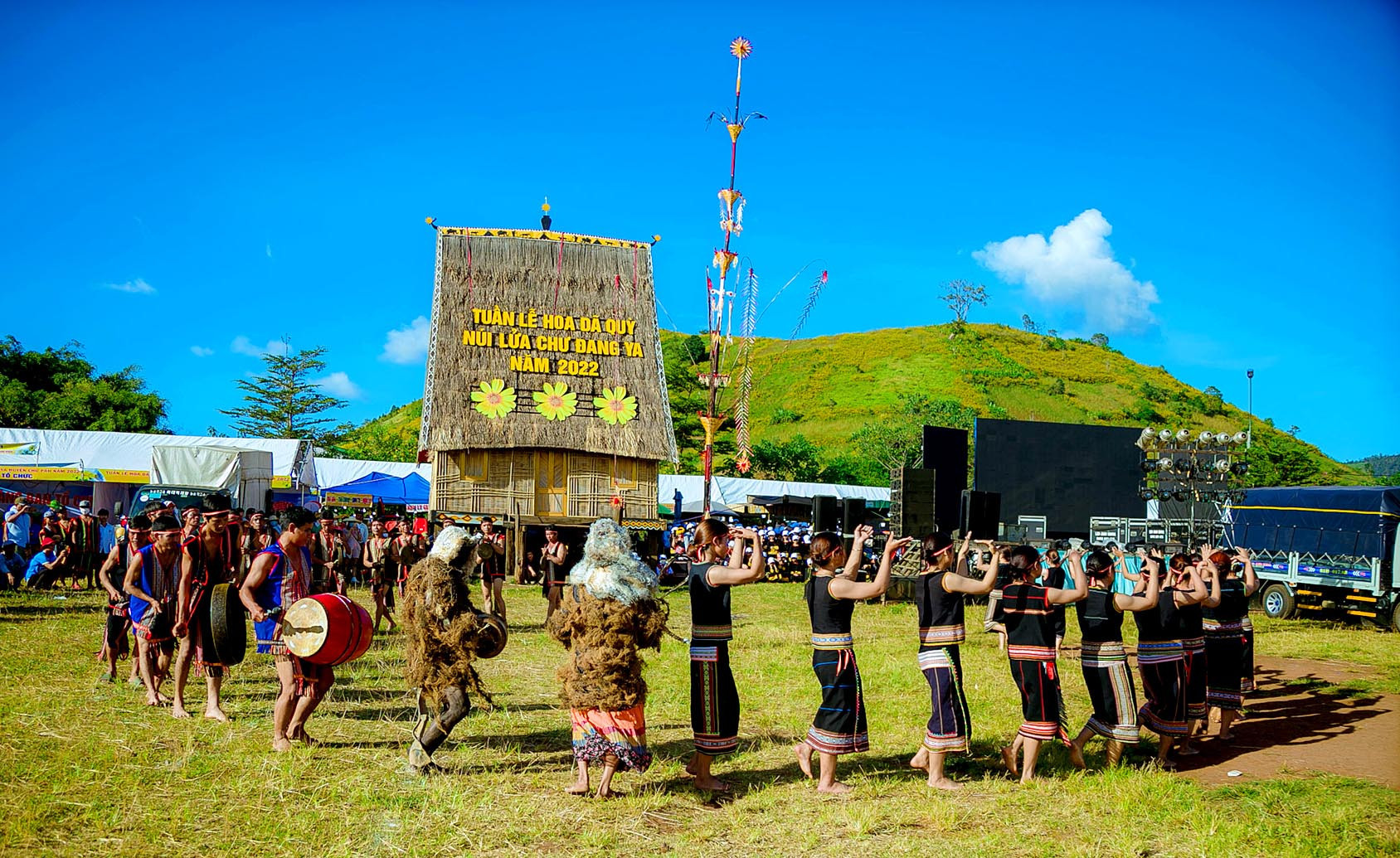
The unique identity of the red basalt land
Gia Lai province is the homeland of two ethnic groups of Jrai and Bahnar. From generation to generation, the Jrai and Bahnar peoples have created their own culture with the unique identity of the red basalt land, a land that has many traces of ancient culture. Gia Lai has a treasure trove of national cultural heritage that has the power to attract researchers.
The culture of ethnic minorities in Gia Lai has its own characteristics, which are: Tradition, solidarity, democracy, equality, love for people and nature; Diversity in the expression of customs, practices, beliefs, and festivals in folk cultural activities; The intertwining of different cultural values creates the richness of the cultural identity of ethnic minorities in Gia Lai.
During the festival season, the sound of gongs urges people to go to jubilant and bustling festivals. There, people seem to immerse themselves in the vibrant atmosphere, excited by the urgent sounds of gongs of the buffalo stabbing festival... Besides jars of can wine, people sing folk songs that take people into the immense realm. Somewhere, the sound of the T'rung instrument rumbles like a roaring stream, besides the soft, whispering sound of the gong instrument, the resonant, immense sound of the Klong put,
Preserving and promoting community-based cultural heritage values
Although the amount of cultural heritage of the ethnic groups in Gia Lai that the authorities have collected and excavated is not large, it has proven that the residents of the northern Central Highlands have a developed culture, which is not inferior to other ethnic groups. In recent times, the strengthening and building of cultural institutions to serve the people has made an important contribution to improving cultural life at the grassroots level, while also contributing to preserving and promoting the value of heritage.
The province's culture and information sector has paid special attention to mobilizing people to build communal houses, cultural houses, and long houses as community living houses. Because communal houses have been part of the lives of ethnic minorities in Gia Lai in particular and residents of the Truong Son - Central Highlands cultural region in general for a very long time. Currently, Gia Lai has 581 communal houses, including 115 cultural communal houses.
In order for these institutions to operate regularly, Gia Lai focuses on building gong teams as the core for main activities at communal houses and cultural communal houses. To date, Gia Lai has had 668 gong teams in hamlets and villages. In addition to the function of preserving the traditional cultural heritage of ethnic groups, this force also works with 16 mobile information teams and three cinema teams to do a good job of propagating policies, the Party's guidelines, the State's policies and laws to the people, contributing to improving the level of cultural enjoyment of the Gia Rai and Ba Na people.
The collection and preservation of ethnic cultural heritage to serve the Gia Rai, Ba Na communities and ethnic minority areas is also emphasized, such as: collecting and publishing folk literature works (especially epics); folk songs; restoring traditional festivals; making statistics and surveys of musical instruments like gongs, musical instruments, wooden drums... The province also pays attention to developing traditional craft villages such as: brocade weaving, sculpting, carving, and making traditional musical instruments. Gia Lai is one of five Central Highlands provinces has the Central Highlands Gong Cultural Space recognized by UNESCO as a representative intangible cultural heritage of humanity.
The province also makes 456 intangible cultural heritage records, including 3 heritage sites included in the National Intangible Cultural Heritage List by the Ministry of Culture, Sports and Tourism, including: Gong cultural space, The epic of the Ba Na people in the 4 eastern districts of the province and the Rain Praying Ceremony of Yang Potao Apui.
In 2020 and 2021, the Department of Culture, Sports and Tourism organized an inventory of the number of gongs in the entire province, to accurately assess the current situation of gongs in the lives of local ethnic minority communities. Preliminary results show that Gia Lai province still retains 4,500 sets of gongs (compared to the 2008 survey of 5,655 sets of gongs). It is the province with the highest number of gongs among the 5 Central Highlands provinces.
In addition, Gia Lai province has 32 artisans who were awarded the title of Meritorious Artist by the State President. The province has organized many classes to teach gong tuning, statue carving, weaving, and brocade weaving for local ethnic minority students. Many folk rituals and festivals have been restored.
The province regularly maintains gong festivals every two years at the district and commune levels, and every four years at the provincial level; Participates in many traditional cultural and art competitions and festivals at the central, regional and other provinces, creating an environment for owners of gong culture to exchange and learn from each other.
The Program "Weekend gongs - knowledge and experience" organized by the Department of Culture, Sports and Tourism of Gia Lai province, has recently been well received by the public. The program has spread the message "Preserving and promoting the value of community-based cultural heritage" widely to the public.